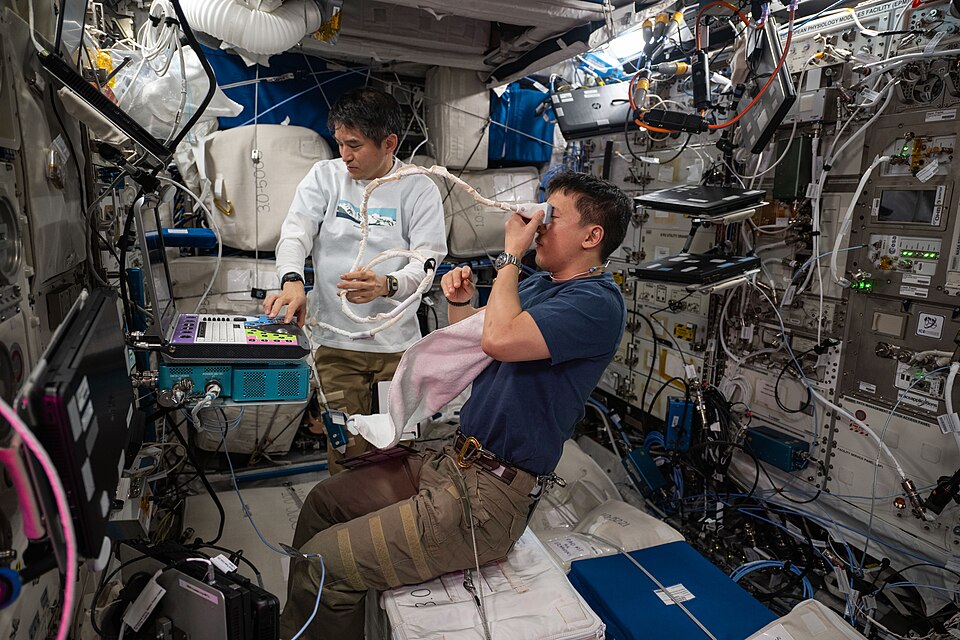NASA Studies Vision Changes Among Astronauts on Space Missions

NASA astronauts aboard the International Space Station (ISS) have reported significant vision changes during long-term missions, leading to the identification of a condition known as Space-Associated Neuro-Ocular Syndrome (SANS). This syndrome manifests as symptoms such as optic disc swelling and alterations in eye shape, compelling researchers to explore the underlying causes and potential treatments.
The phenomenon of vision impairment among astronauts first came to light as missions extended beyond the standard six-month duration. According to Dr. John Smith, an ophthalmologist at the University of Houston, “As astronauts spend extended periods in microgravity, the fluids in their bodies shift, leading to increased intracranial pressure and changes in vision.” This insight aligns with findings from NASA’s Fluid Shifts investigation, which ran from 2015 to 2020 and was the first to document altered blood drainage patterns from the brain in a microgravity environment.
One of the primary studies examining SANS is the ongoing Thigh Cuff investigation, which aims to determine if wearing tight cuffs on the legs can redistribute bodily fluids away from the head and mitigate the symptoms of SANS. Dr. Emily Chen, a research scientist at NASA, stated, “If successful, this simple non-invasive method could serve as an effective countermeasure for future lunar and Martian missions.”
Another noteworthy investigation is the Vision Impairment and Intracranial Pressure (VIIP) study, which utilizes advanced imaging techniques to assess the role of fluid shifts and intracranial pressure on vision changes. The research employs optical coherence tomography to provide detailed images of the retina and optic nerve, enhancing the understanding of the physiological alterations that occur in space. Dr. Sarah Johnson, Professor of Neuroscience at Stanford University, remarked, “Our findings suggest that monitoring the optic nerve sheath diameter could be a promising approach for identifying astronauts at risk of developing SANS.”
In addition to these studies, the SANSORI investigation by the Canadian Space Agency has explored the mechanical properties of eye tissues in microgravity, revealing that changes in tissue stiffness may contribute to the onset of SANS. This research could have implications not only for astronauts but also for aging populations on Earth. Dr. Robert Lee, a biomechanical engineer at McGill University, noted, “Understanding how microgravity affects eye tissue may lead to new treatments for conditions like glaucoma and myopia.”
The implications of this research extend beyond individual health, as NASA aims to ensure the safety and well-being of astronauts on missions to the Moon and Mars. As technology advances, the integration of artificial gravity methods is being considered as a potential countermeasure against the physiological changes experienced in space. Preliminary research by JAXA has indicated that artificial gravity may alleviate some of the adverse effects on vision and overall health.
In conclusion, ongoing investigations into SANS and associated vision changes represent a critical area of research for space exploration. The findings may not only enhance the safety of astronauts during future missions but also contribute to a broader understanding of ocular health challenges faced by individuals on Earth. As Dr. Chen succinctly stated, “What we learn from space can have far-reaching benefits for humanity.” These studies underscore the importance of continued investment in space research and its potential to yield transformative health insights.
As NASA prepares for its Artemis missions to return humans to the Moon and eventually to Mars, addressing the health effects of microgravity, including SANS, remains a top priority. The outcomes of these studies will be instrumental in shaping the future of human space exploration and ensuring the well-being of astronauts against the backdrop of long-duration spaceflight.
Advertisement
Tags
Advertisement





